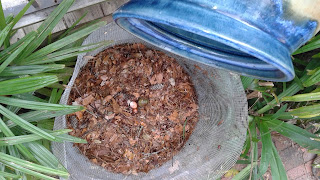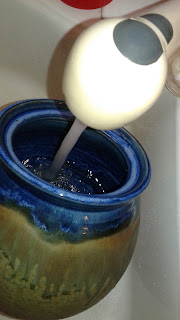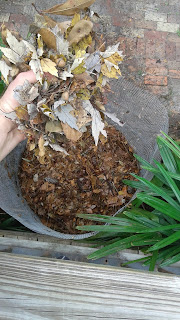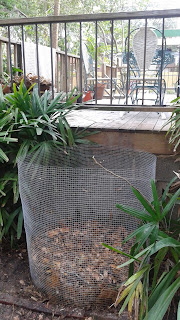But really. :)
Whenever I think of home gardening systems, I always reflect back on my grandmother. She gardened up until the week she died at 93. She planted by the signs and assured me that's why her collards were not eaten up by bugs and were able to grow for 3 years running and up to 8 or 9 feet tall. She had a little rototiller, planted straight rows, mulched by spreading leaves to keep the weeds down. She threw out a little 10-10-10 from time to time and kept the cabbage worms at bay with Sevin dust. She hoed if the weeds called for it. But mostly, she harvested. Her pots were always full and her freezer always stuffed with produce: collards, mustards, turnips, peas, tomato gravy, squash, you name it.
Now, I don't use 10-10-10 or sevin dust, and I'm not big on tilling. However, the thing I continue to take away from my granny was the simplicity of her systems. So, as I've developed my own composting system over the years, my primary aim is to keep it simple. Easy is the name of the game.
Before I outline how I compost, I've got two disclaimers for you. First, backyard composting is exempt from regulations (at least at the state-level-- that I know about). If you're composting at scale for use in a market-garden or farm (from which you'll sell produce), you'll need to be mindful of the state guidelines established to ensure sanitation, namely to turn your pile at least 5 times in the first 15 days, achieving an internal pile temperature of 140 degrees prior to each turn.
My second disclaimer is that I compost primarily for the purpose of eliminating food waste from my trashcan. I hate the smell of rotting food; it is, as teenagers say, "Nasty!" Though I use the finished compost I generate for my fruit trees and at times in my raised beds, a perfect finished-compost is of secondary importance for me... primarily because my household need for finished-compost typically outpaces my capacity to generate material- no matter how "perfect" my system.
So, enough waiting: Here's my compost system in 6 Steps:
#1 Food waste goes into a ceramic pot next to my sink. (I've also used a plastic ice cream bucket, a tupperware, and glass bowl with a plate on it). Some people are compost vegans (by which I mean they only compost raw fruit and veggie scraps). I'm not. If it rots in the woods, it goes in.
#2 Empty food waste into a wire basket immediately off of my back porch. Notice the bottom layer of leaves.
#3 Fill up compost bucket with water to rinse it out and pour waste water onto compost pile to help keep the pile moist. (Sometimes I add the water when it's still full of food scraps to avoid a second trip from my sink).
#4 Add a handful of leaves on top of *every* container-full of food waste. This covers the unsightliness of food waste. Also, if I consistently layer leaves atop every container-full of food waste, there is essentially no odor. The smell of rotten food in a compost pile is most-of-the-time due to anaerobic bacteria which thrive in mucky piles of wet food-on-food.
(I keep leaves in a couple plant pots in the corner of my porch. I refill the plant pots about once a month, as necessary from bags of leaves I store in the corner of my yard).
#5 Once the food-waste and leaves fill up to the brim of my wire basket (once or twice a year), I use a pitch fork or shovel to turn it into an adjacent wire basket just a little further from my porch.
I usually pull the basket up, off the pile to make the shoveling easier. Turning mixes the relatively newer food waste near the top (which is still identifiable food scraps) with the more broken down material at the bottom of the pile. It also introduces a lot of air into the pile which helps aerobic bacteria get to work. If the compost is moist like a wrung-out sponge, all I do it turn it. If it is dry and dusty/powdery as I'm turning, I'll water it a little. In 2-4 months, this pile will a)reduce in volume by about 1/3 to 1/2, and b)all but the very top and outside leaves will be decomposed finished compost. When I'm ready to use it, I typically pull the wire basket up and off, and rake away the exterior identifiable leaves. The rest is the good stuff.
#6 To keep the system going, I'll replace the original wire basket in place right off my porch and add a small bag of leaves at the bottom to ensure breathability from the bottom of the pile.
(Notice that my compost wire basket is just feet away from my porch table. If my compost was stinky, I certainly wouldn't place it so close to where I eat dinner.)
Here are a few parting notes about...
- Air and Water - The ultimate condition for aerobic bacteria (the "good guys" who require air, or, more specifically, oxygen) is a moist but airy environment like a wrung-out sponge. By the laziest methods possible, I maintain moisture by rinsing out my ceramic food waste container and dumping the waste-water on my pile, and I maintain air flow (or aerobic conditions) by layering food waste with leaves.
- "Critters" - I have two cats, and, therefore, don't have a problem with rats. If I ever notice a problem, I'll create a top for my wire baskets out of hardware cloth, which will allow the rain to continue to fall into my pile. If I can't figure that out, I'll just put a piece of plywood on top.
- Location - Like I said, I'm lazy. The closer the better. I don't want an extra chore, I want compost. That's why my pile is right next to my back porch. Also, if it's stinky, I can't ignore it, so I'm, most likely, going to fix the problem before my neighbors complain.
- Odor - If your compost stinks, it's because there is not enough carbon or air. The solution to both of these is to get religious about adding leaves on top of every dump of food scraps.
- Ants - If your compost has a a full-on ant bed in it, typically that's an indicator that your pile is too dry. Wet it down with the hose to start and then make sure you're adding your food waste container waste water to the pile each time you empty.
- Weeds - I add garden scraps and weeds to my pile as well but only those weeds that a)have not made seeds and b)are not hell-froze-over-and-it-went-on-living type weeds. For instance, bermuda grass I literally throw in the middle of the road to kill it... the same goes for nut grass. Neither, God willing, will come anywhere near my compost pile-- ever!
If you're local and have questions about your own compost system, I'm happy to answer questions and offer guidance as part of a food garden consultation, which you can book here.
That's it! Happy Composting!
- - -
If I can support you in growing your groceries locally (here in NE FL)...
please, click here to see my services & book me for a consultation, so I can assess your site; we'll discuss design, answer your questions, talk #s, and get your project lined up. I offer turn-key raised bed food garden support services. Also, with the fall season on the horizon if you'd like me to lead a #GrowYourGroceries the Easy Way workshop in your neighborhood or for your organization, shoot me an email.
If you'd like support with a project beyond NE FL...
I thrive on collaboration and new ideas, so please send me an email.
please, click here to see my services & book me for a consultation, so I can assess your site; we'll discuss design, answer your questions, talk #s, and get your project lined up. I offer turn-key raised bed food garden support services. Also, with the fall season on the horizon if you'd like me to lead a #GrowYourGroceries the Easy Way workshop in your neighborhood or for your organization, shoot me an email.
If you'd like support with a project beyond NE FL...
I thrive on collaboration and new ideas, so please send me an email.
If you'd like to support me...
in freely sharing my stories & expertise, please consider passing along this article to a friend. Each of my articles take 5-10 hours of resource gathering, writing, and editing, so I want to make sure they don't just sit on the digital shelf.
PS- Keep abreast of my workshops & speaking engagements here.
Respectfully,PS- Keep abreast of my workshops & speaking engagements here.
Nathan Ballentine (Man in Overalls)
Itinerant Urban Farmer, Entrepreneur, Educator, Community Organizer
Growing in Jacksonville, FL. Connecting Globally.
(904) 240-9592
Email Man In Overalls at Gmail dot com
Man in Overalls on FB & IG
ManInOveralls.com
Blog - Services - Projects - Resources - About
Receive Man in Overalls' "semi-monthly" updates
Get them emailed to you & receive free "What Can You Grow in a Square" planting guide







